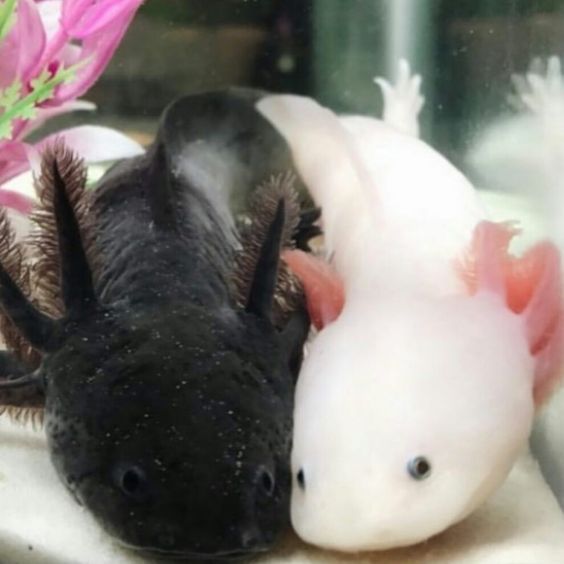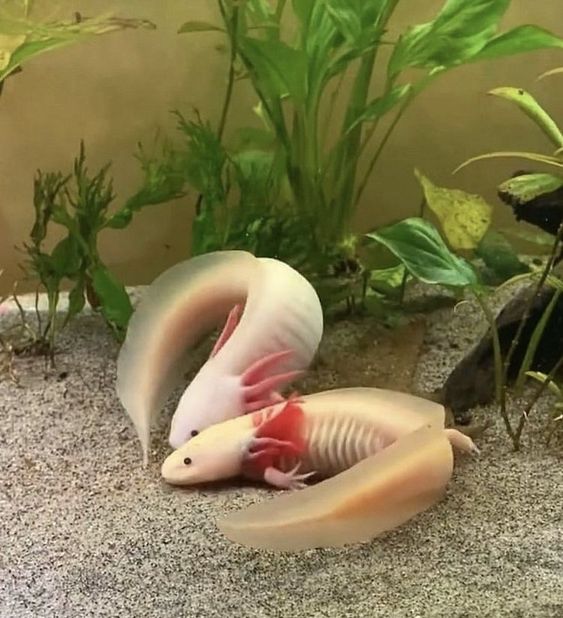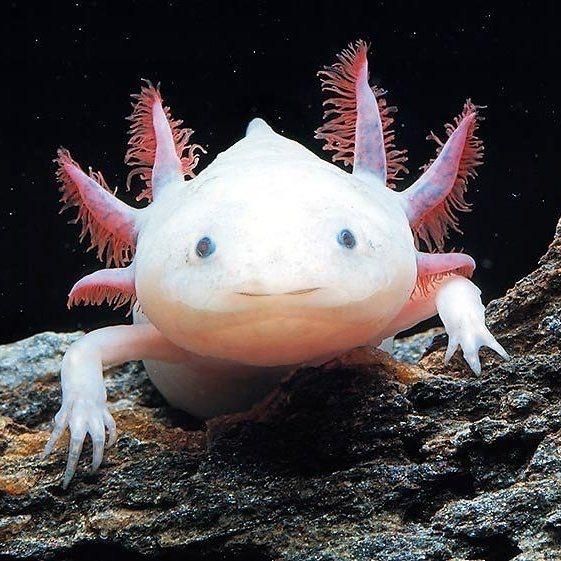
Axolotls are fascinating aquatic creatures that captivate many hobbyists with their unique appearance and behaviors. One common question that arises is whether two axolotls can coexist peacefully in the same habitat. The answer is both yes and no, as it depends on several factors. While it’s possible for two axolotls to live together, it’s crucial to consider their genders, sizes, and temperaments. Male axolotls, in particular, can be territorial and may engage in aggressive behaviors when sharing space. To enhance the chances of successful cohabitation, it’s important to follow specific guidelines for introduction, provide a spacious and well-maintained tank, and monitor their interactions closely. This article will delve into the intricacies of keeping two axolotls together and provide valuable insights into their compatibility and behavior. “Can 2 Axolotls Live Together”
How to Introduce 2 Axolotls to Each Other
Introducing two axolotls to each other is a delicate process that requires careful planning and observation. Rushing the introduction can lead to stress, aggression, and potential harm to the axolotls. To ensure a smooth transition, gradual introduction is the key. Begin by setting up a separate quarantine tank, where you can closely monitor the newcomers for any signs of illness or stress. Quarantine is an essential step to prevent the spread of diseases and parasites. Once you’re confident that the new axolotl is healthy, it’s time to introduce them to the main tank. During this process, monitoring their behavior is crucial. Pay close attention to their interactions, such as chasing or nipping, as these can indicate potential issues. In this section, we’ll explore the steps for introducing axolotls to each other safely, the significance of quarantine, and the essential role of monitoring their behavior during the transition.
Gradual Introduction
The key to successfully introducing two axolotls to each other is a gradual approach. Sudden, abrupt introductions can lead to stress and aggression, potentially causing harm to the axolotls. Instead, it’s advisable to take your time and ensure both axolotls adjust to the new environment and each other. Begin by placing the new axolotl in a separate quarantine tank. This allows you to observe its behavior and health without affecting the established axolotl’s territory. Quarantine also helps prevent the spread of diseases or parasites, which can be a common concern when introducing new axolotls. After the quarantine period, gradually acclimate the newcomers to the main tank to minimize stress and potential conflicts. This method provides the best chance for a harmonious coexistence between your axolotls.
Quarantine
Quarantine is a critical step in the process of introducing new axolotls to your existing tank. This period serves multiple purposes, primarily ensuring the health of the newcomers and preventing the spread of diseases within your main tank. During quarantine, you can closely monitor the new axolotl for any signs of illness, stress, or parasites. If any issues arise, they can be addressed without affecting the established axolotl’s health. The quarantine tank should be set up with similar water parameters and conditions to those of the main tank, with proper filtration and a hiding spot for the axolotl’s comfort. It’s essential to maintain a vigilant eye on the quarantined axolotl, conducting daily checks for any concerning symptoms. Quarantine may last for a few weeks to ensure the new axolotl is in optimal health before introducing it to the main tank, minimizing the risks associated with hasty introductions.
What to Do If Your Axolotls Fight with Each Other
Axolotls are generally known for their peaceful and gentle nature, but occasionally, conflicts may arise between them. If you notice your axolotls fighting, it’s essential to take prompt action to prevent injury and ensure their well-being. This article explores the steps you should take if your axolotls are engaged in aggressive behavior, including separating them, identifying potential causes of the conflict, and reintroducing them once the issues have been resolved. Understanding the dynamics of axolotl interactions and how to manage conflicts can help maintain a harmonious environment in your tank.
If your axolotls, be they GFP Axolotls or golden albino axolotls, engage in aggressive behavior, it’s essential to intervene promptly. Separate them into individual tanks to prevent injuries. Assess tank conditions, provide hiding spots, and ensure proper feeding. Addressing the cause promptly ensures a harmonious and stress-free environment for these fascinating aquatic companions.
Separation
When axolotls engage in aggressive behavior, separation is the immediate step to take. This involves moving the conflicting axolotls into separate tanks or enclosures to prevent further harm. Aggressive behaviors may include biting, nipping, chasing, or even physical injury, so quick action is crucial. Separating the axolotls gives them a chance to calm down and reduces the risk of serious harm. During the separation period, you should also ensure each axolotl’s individual needs are met, including appropriate water parameters and a hiding spot for security. Observing them during this time can provide insights into their behavior and potential triggers for the conflict.
Potential Causes
To address and prevent future conflicts, it’s important to identify the potential causes of the aggression between your axolotls. Various factors can contribute to their discord. These may include territorial disputes, overcrowding in the tank, insufficient hiding spots, differences in size, or even health issues. Understanding the underlying reasons behind the aggression can help you make necessary adjustments to the tank’s setup and management. For example, ensuring adequate hiding spots, maintaining proper water quality, and providing enough space for each axolotl can alleviate some causes of aggression. It’s also essential to consider the axolotls’ individual personalities, as some may be more territorial or aggressive than others. By addressing the potential causes, you can create a more harmonious living environment for your axolotls.
Reintroduction
Once you have separated the fighting axolotls and addressed the potential causes of their conflict, you can consider reintroducing them under controlled circumstances. Reintroduction should be a gradual process to monitor their behavior and ensure that the conflict does not escalate again. To reintroduce them successfully, follow the steps for introducing new axolotls to each other, which include using a quarantine tank and closely observing their interactions. It’s crucial to remain patient during this process, as axolotls may need time to adjust and establish a new hierarchy. Reintroduction can be a successful way to allow your axolotls to coexist peacefully after addressing and resolving their initial conflicts.
Can You Keep Two Female Axolotls Together
Keeping two female axolotls together is a common practice among axolotl enthusiasts, and it’s generally a feasible arrangement. However, while females are often more compatible than males, there are factors to consider before introducing them. This article explores the compatibility of female axolotls, their potential territorial behavior, and provides tips for successfully keeping two female axolotls together. By understanding the dynamics between female axolotls and implementing appropriate measures, you can create a harmonious living environment for your aquatic pets.
While “Can Axolotls Live with Other Fish?” is a common question, keeping two female axolotls together is generally manageable. Ensure a spacious tank with suitable hiding spots and closely monitor their behavior. Providing the Best Tanks for Axolotl, maintaining optimal conditions, and addressing any aggression ensures a harmonious cohabitation for these unique aquatic pets.
Female Compatibility
Female axolotls are generally more compatible with each other compared to males. They tend to exhibit fewer territorial and aggressive behaviors, making cohabitation more likely to succeed. However, it’s important to keep in mind that individual axolotls can have unique personalities. While many female pairs get along well, there are instances of aggression or territorial disputes. To maximize compatibility, it’s advisable to introduce females of similar sizes and ages, as this reduces the likelihood of conflicts related to differences in size and maturity.
Territorial Behavior
Despite their generally peaceful nature, female axolotls can still display territorial behavior, especially when they perceive a lack of personal space or hiding spots. Territorial behavior may manifest as chasing, nipping, or even occasional dominance displays. It’s essential to provide a spacious and well-structured tank with ample hiding places to minimize territorial disputes. Ensuring that each axolotl has its own designated area and access to hiding spots can help prevent conflicts related to territorial behavior.
Tips for Success
Successfully keeping two female axolotls together requires careful planning and attention to their needs. Here are some tips for creating a harmonious cohabitation:
- Tank Size: Provide a spacious tank with a minimum of 20 gallons (76 liters) to ensure that each axolotl has enough space to establish its territory.
- Hiding Spots: Include plenty of hiding spots in the tank using decorations like caves, plants, or PVC pipes. This gives the axolotls the security they need and helps minimize territorial behavior.
- Feeding Separately: During feeding times, it’s a good idea to separate the axolotls by using a plastic divider or feeding tongs to avoid competition over food.
- Monitoring: Keep a close eye on their interactions. If you notice persistent aggression or injuries, be prepared to separate them and reintroduce them later.
- Compatible Pairing: When introducing two female axolotls, select individuals of similar sizes and ages. This can reduce the chances of territorial disputes and dominance behavior.
Can You Keep Male and Female Axolotls Together

Keeping male and female axolotls together can be both a fascinating and challenging endeavor. Unlike many other amphibians, axolotls are known for their aquatic lifestyle, which means that their mating and breeding behaviors are unique. While it is possible to house male and female axolotls together, it comes with certain considerations and potential challenges. This article delves into the intricacies of mixed-gender housing for axolotls, offering insights into breeding considerations, habitat setup, and tips for maintaining a harmonious cohabitation.
Mixed Gender Housing
Mixed-gender housing, where male and female axolotls are kept together, can lead to potential breeding if not managed carefully. Male axolotls may become aggressive or overly persistent in their courtship behaviors, which can stress the females. Moreover, breeding can be a demanding process, and if not planned for, it may lead to unwanted offspring that require separate care. To house male and female axolotls together, it’s important to ensure the tank is spacious, well-structured with hiding spots, and closely monitored. Additionally, consider the compatibility of the individuals and their health status before introducing them.
Breeding Considerations
Breeding axolotls can be a rewarding experience, but it requires careful planning and attention to the specific needs of the species. Male axolotls may exhibit courtship behaviors, such as nipping and circling, which are part of their mating rituals. However, these behaviors can escalate into aggression if not reciprocated by the females. It’s important to provide a suitable breeding environment if you intend to house male and female axolotls together. This includes maintaining proper water parameters, a stable temperature, and the introduction of a suitable breeding substrate for the female to deposit her eggs. Breeding axolotls also necessitates a separate tank for the offspring once they hatch, as they are delicate and require specific care to thrive.
Habitat Setup
The habitat setup plays a crucial role in the successful cohabitation of male and female axolotls. To accommodate their unique breeding needs and behaviors, it’s essential to create an environment that allows for natural mating and egg deposition. This includes providing a spacious tank with plenty of hiding spots, plants, and structures where axolotls can lay their eggs. A suitable substrate, such as a sponge or a spawning mat, is necessary for the females to anchor their eggs. Additionally, maintaining the right water parameters, such as a temperature between 14-18°C (57-64°F), is crucial for stimulating breeding behaviors. Proper habitat setup ensures a more natural and comfortable environment for both male and female axolotls and increases the chances of successful breeding if that’s the desired outcome.
FAQs
Q: Do axolotls need companionship?
A: Axolotls are generally solitary animals and do not require companionship. They can be kept alone without issues.
Q: Can I keep two male axolotls together?
A: It’s generally best to avoid keeping two male axolotls together, as they are more likely to display territorial and aggressive behaviors.
Q: What is the minimum tank size for two axolotls?
A: For two axolotls, a tank with a minimum capacity of 20 gallons is recommended to provide ample space for both.
Q: Do axolotls recognize each other?
A: Axolotls do not have a strong social recognition system, so they may not recognize each other as individuals.
Q: Can I keep different axolotl species together?
A: It’s generally best to keep axolotls of the same species together to ensure compatibility and avoid potential crossbreeding.
Q: How often should I monitor my axolotls when they are first introduced?
A: During the initial introduction period, it’s a good idea to monitor them closely for the first few hours to ensure they are not displaying aggressive behavior.
Q: Can I add more axolotls to the tank after the initial introduction?
A: Adding more axolotls after the initial introduction can disrupt the established hierarchy and may lead to aggression. It’s best to avoid this unless you have a larger tank.
Q: Do axolotls need hiding spots in the tank when kept together?
A: Yes, providing hiding spots and decorations can help reduce stress and aggression among axolotls.
Q: How do I prevent unintentional breeding between male and female axolotls?
A: You can prevent unintentional breeding by keeping male and female axolotls in separate tanks or providing them with adequate space and supervision to minimize mating opportunities.
Q: Are there any specific signs of stress or discomfort to watch for in axolotls kept together?
A: Signs of stress may include reduced appetite, unusual swimming patterns, and pale coloring. If you observe these signs, it’s essential to address the underlying issue promptly.
Conclusion
In conclusion, the world of axolotl care and cohabitation is a nuanced one, filled with considerations and choices that reflect the unique nature of these captivating aquatic creatures. Whether you are contemplating introducing two axolotls, managing conflicts between them, or deciding on mixed-gender housing, it’s imperative to prioritize their well-being and understand the implications of your choices.
Introducing axolotls to each other demands patience and a gradual approach. By creating the right environment and monitoring their interactions, you can increase the likelihood of peaceful cohabitation. However, it’s crucial to be prepared for potential conflicts and have separation techniques at your disposal should the need arise.
With 3 years of devoted companionship alongside my aquatic friend, Bob, I’ve gained profound insights into the captivating world of fishkeeping. From understanding behavior to ensuring optimal health, my journey with Bob has enriched my expertise in all things aquatic.



